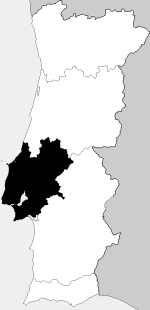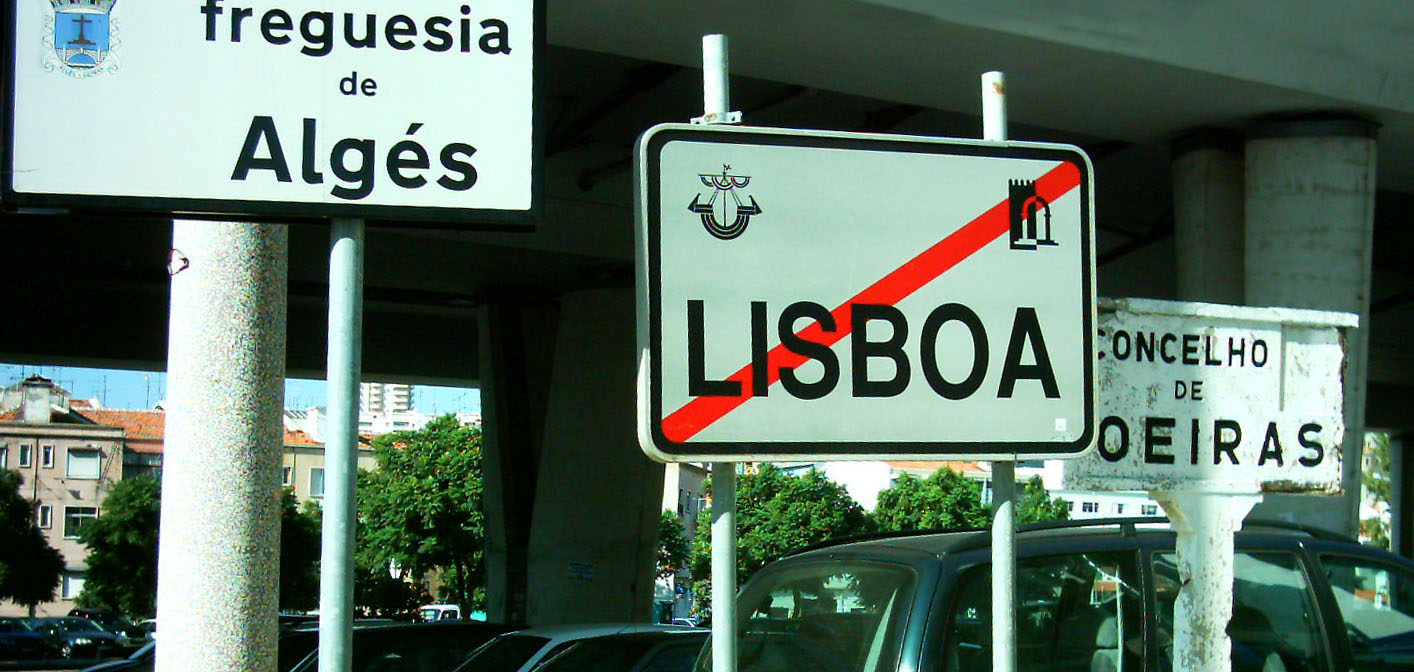|
Lisboa E Vale Do Tejo
Lisboa e Vale do Tejo (; en, Lisbon and Tagus Valley) was one of the five regions of Portugal ( NUTS II subdivisions). Today two of the subregions are in the new Lisboa Region, two in the Centro Region and one in the Alentejo Region. The region still exists as the area of intervention of the CDDR planning region. It had 3,447,173 inhabitants (2001), and its area was 11,930 km². NUTS II region and area of intervention of the CCDR-LVT "Despite the territorial configuration for statistical purposes (National Statistical System in Portugal), in force since 2007, matching the NUTS II the Lisbon, Region Greater Lisbon (AML) - composed only NUTSIII Greater Lisbon and Setúbal Peninsula - the area of intervention of the CCDRLVT - Steering Committee and Regional Development, abbreviated to CCDR - (the Lisbon and the Tagus Valley), continues to be composed of 5 NUTSIII (Sub-regions: Greater Lisbon, Setúbal Peninsula, Middle Tagus, and Lezíria West Coast). For the Regional Fun ... [...More Info...] [...Related Items...] OR: [Wikipedia] [Google] [Baidu] |
Regions Of Portugal
Administratively, Portugal is ''de jure'' unitary and decentralized state. Nonetheless, operationally, it is a highly centralized system with administrative divisions organized into three tiers.Carlos Nuno Silva (2002), p.5 The State is organized under the principles of subsidiarity, local government autonomy, and democratic decentralization of the public service. The government structure is based on the 1976 Constitution, adopted after the 1974 Carnation Revolution. In addition to defining the status of the autonomous regions ( pt, regiões autónomas) Azores and Madeira (Articles 225-234), the Constitution specifically identifies the three tiers of government (Article 235-262): civil parishes (''freguesias''), municipalities (''municípios'') and administrative regions (). In addition, the Portuguese territory was redefined during European integration, under a system of statistical regions and subregions known as Nomenclature of Territorial Units for Statistics. These NUTS d ... [...More Info...] [...Related Items...] OR: [Wikipedia] [Google] [Baidu] |
Nomenclature Of Territorial Units For Statistics
Nomenclature of Territorial Units for Statistics or NUTS (french: Nomenclature des unités territoriales statistiques) is a geocode standard for referencing the subdivisions of countries for statistical purposes. The standard, adopted in 2003, is developed and regulated by the European Union, and thus only covers the member states of the EU in detail. The Nomenclature of Territorial Units for Statistics is instrumental in the European Union's Structural Funds and Cohesion Fund delivery mechanisms and for locating the area where goods and services subject to European public procurement legislation are to be delivered. For each EU member country, a hierarchy of three NUTS levels is established by Eurostat in agreement with each member state; the subdivisions in some levels do not necessarily correspond to administrative divisions within the country. A NUTS code begins with a two-letter code referencing the country, as abbreviated in the European Union's Interinstitutional Style ... [...More Info...] [...Related Items...] OR: [Wikipedia] [Google] [Baidu] |
Lisboa Region
Lisbon Region ( pt, Região de Lisboa, ) is one of the seven NUTS II designated regions of Portugal, which coincides with the NUTS III subregion Lisbon Metropolitan Area. The region covers an area of 3001.95 km2 (the smallest region on mainland Portugal) and includes a population of 2,815,851 inhabitants according to the 2011 census (the second most populated region in Portugal after the Norte region), a density of 1039 inhabitants/km2. Considered as representing the Lisbon Metropolitan Region. It is a region of significant importance in industry (light and heavy), services, and it is highly urbanized. The gross domestic product (GDP) of the region was 73.3 billion euros in 2018, accounting for 36% of Portugal's economic output. GDP per capita adjusted for purchasing power was 30,200 euros or 100% of the EU27 average in the same year. The GDP per employee was 92% of the EU average. History Prior to 2002, the area was included within the NUTS II region of Lisbon and Tagu ... [...More Info...] [...Related Items...] OR: [Wikipedia] [Google] [Baidu] |
Centro Region
The Central Region ( pt, Região do Centro, ) or Central Portugal is one of the statistical regions of Portugal. The cities with major administrative status inside this region are Coimbra, Aveiro, Viseu, Caldas da Rainha, Leiria, Castelo Branco, Covilhã, Torres Vedras and Guarda. It is one of the seven Regions of Portugal ( NUTS II subdivisions). It is also one of the regions of Europe, as given by the European Union for statistical and geographical purposes. Its area totals . As of 2011, its population totalled 2,327,026 inhabitants, with a population density of 82 inhabitants per square kilometre. History Inhabited by the Lusitanians, an Indo-European people living in the western Iberian Peninsula, the Romans settled in the region and colonized it as a part of the Roman Province of '' Lusitânia''. The Roman town of Conímbriga, near Coimbra, is among the most noted and well-preserved remains of that period. After the fall of the Western Roman Empire, Visigoths were the ma ... [...More Info...] [...Related Items...] OR: [Wikipedia] [Google] [Baidu] |
Alentejo Region
Alentejo Region () is one of the seven NUTS 2 regions of Portugal. It covers all of the historical Alentejo Province and part of the historical Ribatejo and Estremadura provinces. The greater region is defined within Portugal by the land bordering the left bank of the river Tagus to the North and extending to the South where it borders the Algarve region. The origin of its name, "além" + "Tejo" combined as Alentejo, literally translates to "Beyond-the-Tagus". However, a large part of the subregion Lezíria do Tejo is located on the right bank of the Tagus. The Alentejo is completely located beyond the left margin of the Tagus River. Its main cities are Évora, Elvas, Portalegre, Beja, Moura, Serpa, Sines and Santarém. Subdivisions The region is subdivided into five intermunicipal communities ( NUTS 3 regions): * Alentejo Litoral * Alentejo Central * Alto Alentejo * Baixo Alentejo * Lezíria do Tejo Demographics The resident population of the Alentej ... [...More Info...] [...Related Items...] OR: [Wikipedia] [Google] [Baidu] |
Lisboa E Vale Do Tejo NUTS 2
Lisbon (; pt, Lisboa ) is the capital and largest city of Portugal, with an estimated population of 544,851 within its administrative limits in an area of 100.05 km2. Lisbon's urban area extends beyond the city's administrative limits with a population of around 2.7 million people, being the 11th-most populous urban area in the European Union.Demographia: World Urban Areas - demographia.com, 06.2021 About 3 million people live in the , making it the third largest metropolitan area in the , ... [...More Info...] [...Related Items...] OR: [Wikipedia] [Google] [Baidu] |
Grande Lisboa
Grande Lisboa () or Greater Lisbon is a former Portuguese NUTS III subregion integrated in the Lisboa Region. It was abolished at the January 2015 NUTS 3 revision. It is part of the historical Estremadura Province. It includes the capital and prime city of Portugal, Lisbon (''Lisboa'' in Portuguese). It is the main economical subregion of the country. It covers 1,376 km2 and it is the most populous and most densely populated Portuguese subregion (2,042,477 inhabitants and 1,483.6 inhabitants/km2http://habitacao.cm-lisboa.pt/documentos/1362596653V6gKK1xq6Mw12JO4.pdf ). Overview In spite of getting the name Grande Lisboa, the subregion did not take the entire area of the Lisbon metropolitan area, because it does not include the municipalities on the South bank of the Tagus river estuary, known as Península de Setúbal, which the term at times also applied to. The area is bordered in the North by the Centro Region, in the West by the Atlantic Ocean, in the East by the Ribat ... [...More Info...] [...Related Items...] OR: [Wikipedia] [Google] [Baidu] |
Lezíria Do Tejo
The Comunidade Intermunicipal da Lezíria do Tejo (; English: ''Tagus Floodplain'') is an administrative division in Portugal. It was established as an ''Associação de Municípios'' in 1987, converted into a ''Comunidade Urbana'' in 2003, and converted into a ''Comunidade Intermunicipal'' in November 2008. It is also a NUTS3 subregion of the Alentejo Region. Instituto Nacional de Estatística, 18 March 2015 The seat of the intermunicipal community is the city of ... [...More Info...] [...Related Items...] OR: [Wikipedia] [Google] [Baidu] |
Oeste Subregion
Comunidade Intermunicipal do Oeste ( or ; in English: Intermunicipal Community of the West; abbreviated OesteCIM) is an administrative division of Portugal, located on the country's western central coast. The population in 2011 was 362,540, in an area of . Caldas da Rainha serves as the seat of OesteCIM. The law establishing the framework for intermunicipal communities and metropolitan areas was approved by the Assembly of the Republic (Assembleia da República) on 27 August 2008. On 25 November 2008, the Associação de Municípios do Oeste (Association of Municipalities of the West), by the approval of the municipal assemblies ('' assembleias municipais'') of each of its constituent municipalities, converted itself into the Comunidade Intermunicipal do Oeste. The law formally establishing the names, borders, and duties of the intermunicipal communities and metropolitan areas was approved by the Assembly of the Republic on 12 September 2013. OesteCIM is the successor to Associa� ... [...More Info...] [...Related Items...] OR: [Wikipedia] [Google] [Baidu] |
Península De Setúbal
The Península de Setúbal (; English: ''Setúbal Peninsula'') is a former NUTS III subdivision of Portuguese region of Lisbon (NUTS II). It was abolished at the January 2015 NUTS 3 revision. Instituto Nacional de Estatística, 18 March 2015 Comprising several municipalities and urban centres, the subregion's capital is , and includes several citie ... [...More Info...] [...Related Items...] OR: [Wikipedia] [Google] [Baidu] |
Lisboa, Region
Lisbon Region ( pt, Região de Lisboa, ) is one of the seven NUTS II designated regions of Portugal, which coincides with the NUTS III subregion Lisbon Metropolitan Area. The region covers an area of 3001.95 km2 (the smallest region on mainland Portugal) and includes a population of 2,815,851 inhabitants according to the 2011 census (the second most populated region in Portugal after the Norte region), a density of 1039 inhabitants/km2. Considered as representing the Lisbon Metropolitan Region. It is a region of significant importance in industry (light and heavy), services, and it is highly urbanized. The gross domestic product (GDP) of the region was 73.3 billion euros in 2018, accounting for 36% of Portugal's economic output. GDP per capita adjusted for purchasing power was 30,200 euros or 100% of the EU27 average in the same year. The GDP per employee was 92% of the EU average. History Prior to 2002, the area was included within the NUTS II region of Lisbon and Tagus ... [...More Info...] [...Related Items...] OR: [Wikipedia] [Google] [Baidu] |





